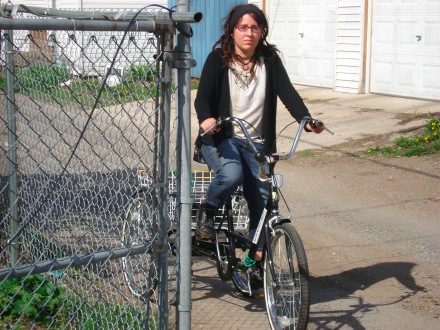My latest column on Grist, up today, is about bicycling with disabilities.
As always, when interviewing people for a story, a heartbreaking amount gets cut for the final version. In this case, I particularly wanted to share some of the practical tips people offered for other folks with disabilities who want to ride. Here are some roughly edited chunks of interview that I wanted to share.
***
Corey Cartwright, owner of Seven Corners Cycles in Portland, didn’t make it into the final cut on Grist (sorry, Corey!). He helped outfit a neighbor with a handcycle — a recumbent three-wheeler powered by hand-cranked pedals — eight years ago. Word got around quickly, and now his shop is known for its willingness to creatively tinker with bicycles and tricycles. “It’s a blast,” Cartwright said. “It’s challenging. You get to flip the whole drive train upside down and get dudes who can or can’t grip various things at different angles, or their bodies cramp up in certain positions. You get to find solutions. It’s all towards the same end goal — to get more people on bikes.”
About the cost of handcycles: “They cost A LOT. Production is not nearly as substantial — they’re making fewer per year, there’s way less overseas outsourcing. The market’s growing, but still kind of small.” Cartwright says the price range is anywhere from $1500 at the very lowest to as much as $12,000.
***
Bob Hudecek in northeast Ohio has a handcycle that he bought at wholesale cost from a distributor after searching for a year and a half: “It’s not easy to get a test ride on a handcycle, not a lot of bike shops carry them and the market’s so small. Some of the ones I’m looking for, all the shifters are up on the handlebars and on the cranks. Because of my limited hand movement, I couldn’t shift. This company in San Diego has it on a post with a twist shift on it. Even with that I had to improvise — I used regular clamps I get at a hardware store. A little improving here and there and you can pretty much accommodate.”
Hudecek also talked about looking for opportunities to ride and meet other handcyclists: “I started doing marathons, and the first one didn’t end so well. It was a year ago in April I decided I was going to ride in the race in Toledo. Around the 20 mile marker I was in the lead of everyone, only a wheelchair guy and another handcyclist near me, it was the three of us. They brought us off the street into a park and it’d rained the night before. I came round the corner too fast and hit the wood decking on the bridge. I lost control and what stopped me was a steel I-beam. I ended up shattering the fifth metatarsal and I didn’t end up finishing the race — that was the worst part.
“Last October I rode in the Columbus marathon and finished that. This year the Cleveland marathon — I’d tried to get in last year but they didn’t allow handcyclists and wheelchairs because of lack of a sponsor. This year there was another handcyclist who got turned down and wasn’t going to take no for an answer and went all the way up the ranks of Marathon USA and the race organizers conceded and allowed for an exhibition. There were ten slots. Eight of us showed up and seven of us finished. We’ve started looking at different races around the country. One of the things about doing a marathon is i do get to meet other guys and gals who are faced with the same challenges. Attitude is everything. ”
***
Cyndi Sutter’s advice to others with physical disabilities who want to try bicycling: “Start on small streets. I suggest a three wheeler at first for groceries, and activities — so you can carry stuff, not just go for a joyride. Get mirrors so you can look behind you. Another reason I chose the three wheeler is it was hard to look behind me on my road bike. Probably a reflective vest and all that good stuff. Get decked.”
She added: “A lot of people need coaching. I was on the member advisory board of the health care I had for disabled people, and I offered to be one of the people who would introduce other folks to public transit. I think people need to be introduced to biking in the same way and outfitted with the proper equipment for their size and their ability. Some people are severely physically challenged or mentally challenged and it’s just out of their realm. But I think public transportation or biking, one of the two, should be available in everybody’s life.”
***
Finally, here’s a video Joe made of a local radio show interview with Portland cyclists who have disabilities, including a handcycling athlete and a man with an artificial leg who rides everywhere with a crutch clamped to his bike frame.
Disabled Cyclists on KBOO from Cantankerous Titles on Vimeo.
Read the original column, The Bike Factor: Disability and the ability to ride a bike.
(Photo at the top provided by Cyndi Sutter.)
